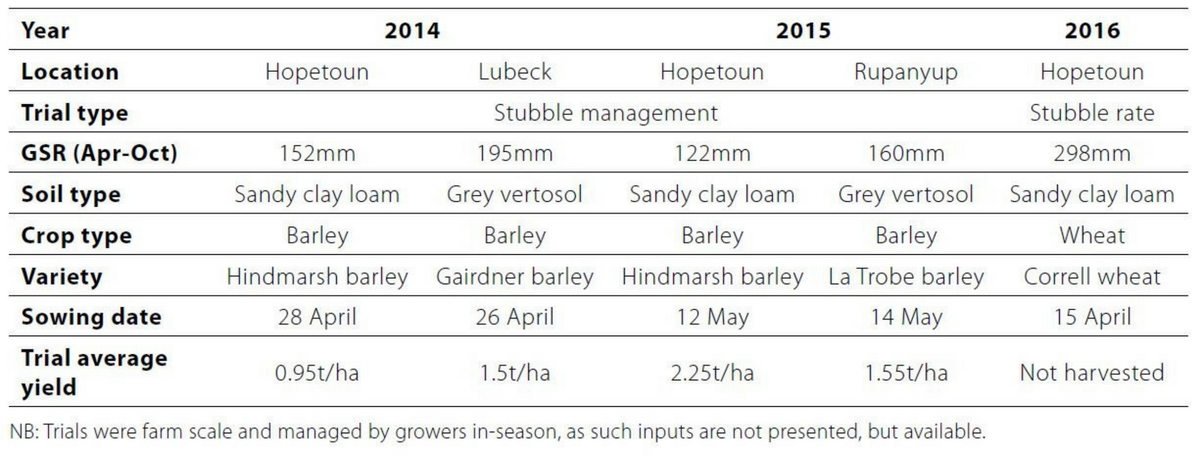Take home messages
- Reducing stubble loads can reduce the severity and duration of frost events under certain conditions. However, under the situation of multiple and severe frost events the influence of stubble is less defined and stubble reduction does not reduce risk.
- In the Mallee, most stubble management practices carried out prior to seeding to increase stubble incorporation or breakdown (cultivation, slashing) did not reduce stubble loads enough to reduce frost severity and duration.
- In the Wimmera, reducing stubble loads did not consistently reduce frost severity or duration possibly due to a combined effect of greater canopy closure with higher yield potential (2014) and higher stubble break down with low stubble levels (2015).
- Stubble management in frost prone areas is not about complete removal of stubble, but reducing it to a level that minimises your risk.
Background
The effect of frost can have a significant impact on the farming system other than just the loss of productivity. It can impact financial situations, the physical and mental health and wellbeing of the individual, and can be a very isolating feeling, as it is not uncommon to see one person drastically affected, and yet a near neighbour emerge unscathed.
Frost impact on the Australian grains industry is calculated to be approximately $360 million in direct and indirect losses annually. For this reason, the GRDC and other partners are investing in research to identify strategies that could lessen the impact of frost, and develop a toolset that commonly affected regions can utilise to minimise the impact of frost events.
Some common strategies to reduce the impact of frost have included zoning, crop selection and time of sowing (TOS). Previous research in Western Australia has shown that removing stubble prior to seeding can reduce the effects of frost, both in terms of severity and duration.
Aim
To investigate the influence of stubble management and rate on the duration, severity and frost damage in frost prone parts of the landscape in the Mallee and Wimmera regions.
Paddock details
Table 1. Paddock details for trials conducted in 2014–2016.
Method
Stubble management trials
Trial sites were selected in frost prone parts of the landscape with cold air drainage onto the site and minimal slope across treatments. Trials were sown to barley in 2014 and 2015, with planned sowing dates on the early end of the sowing window to increase the probability of exposing the trial to frost.
Replicated strip trials of approximately 15-20m x 250m were established with underlying stubble management treatments of removed (burnt), reduced (slashed) and retained (normal farmer practice – standing).
At Rupanyup in 2015 cultivation was used rather than burning to remove stubble. At the Hopetoun site, the trial was located to capture the influence of slope with an elevation down the length of the plots/treatments up to 10m. The results presented in this report only focus on the impact of stubble management on frost low in the landscape. To ensure more uniform frost canopy effects over the trial area the whole trial area was sown as close to a continuous bulk crop canopy as possible using farmer equipment at each of the four locations and managed according to the grower’s standard practice (Table 1). A fungicide was applied at GS31 to reduce the incidence of stubble born disease and negligible disease was observed.
Stubble rate trial
At Hopetoun in 2016, a replicated field trial was established by applying stubble residues to a standing wheat crop over areas of 10m x 10m at 0, 1, 2 and 4t/ha stubble. Barley stubble was used to reduce the incidence of disease in the wheat crop. Due to a dry start to the season, and reduced effectiveness of preemergent herbicides, this trial had a high population of ryegrass present and was cut for hay after anthesis GS65 measurements. Temperature data was still considered valid and collected up until this point.
Trial measurements
Soil samples were taken from all sites for nutrition prior to sowing to a depth of 10cm. Data loggers were installed within each plot to measure canopy temperature every 15 minutes, at a height of 600mm from canopy closure to senescence using unshielded Tinytag temperature loggers (TGP-4017). In stubble management trials, these were placed high and low in the landscape in each plot, while in stubble rate trials they were placed in the middle of each plot.
Stubble biomass was assessed at seeding on three replicates at three locations within each plot. Plant counts were conducted approximately three weeks after sowing at three randomly selected locations in each plot to assess crop emergence. From GS40 (flag leaf sheath extending) onwards, plots were assessed weekly for crop developmental stage. At GS75 (early dough) 30 heads were collected from three locations near temperature sensors for floret sterility (FS) assessments, irrespective of whether frosts occurred previously or not. Biomass cuts were collected at GS89 (hard dough) for harvest index (HI), 1000 grain weight, hectolitre weight and screenings. At maturity, two harvest cuts were taken near the temperature sensors using a small plot header.
Results and interpretation
Across all stubble management trial sites, no measurable effect of stubble treatment was evident on crop emergence or total crop maturity biomass. The stubble reduced treatments of slashing at all trial sites in 2014 and 2015 were relatively ineffective at increasing in-season stubble breakdown due to the low season rainfall. Stubble retained treatments flowered 1–2 days later than the removed stubble treatments across all sites, possibly due to slightly lower canopy temperatures delaying phenology. The differences in floret sterility attributed to frost, were assumed not because of the slight difference in phenology causing frost escape, as other genetic work within the National Frost Initiative (Leske et al. 2017), suggests flowering date differences between treatments need to be greater than a week for this to happen.
Temperature – effect of stubble management
In the Mallee region in 2014 and 2015 retaining stubble increased frost severity. At seven of the 33 frost events at Hopetoun in 2014 and 2015, the stubble retained treatments had lower minimum temperatures (Figures 1 and 2) during September.
In the Wimmera region during four of the 22 frost events at Lubeck in 2014 (Figure 3), the retained stubble increased frost severity. At Rupanyup in 2015 (Figure 4) there was no consistent effect of the stubble management techniques on frost severity. There were four out of the 19 frost events where there were treatment effects, but these were not consistent.
The site did have significant stubble breakdown in both the reduced and retained treatments which reduced the stubble load at flowering to <1t/ha, visual observations. With only a relatively low stubble load in the 2015 season (after the low rainfall/production year of 2014), combined with the higher stubble breakdown in the heavy textured soil, there may be no change in frost severity and duration because the stubble had all broken down below critical level by spring.
In general, in both the Mallee and Wimmera, retaining stubble increased the severity of some frost events or had no effect.
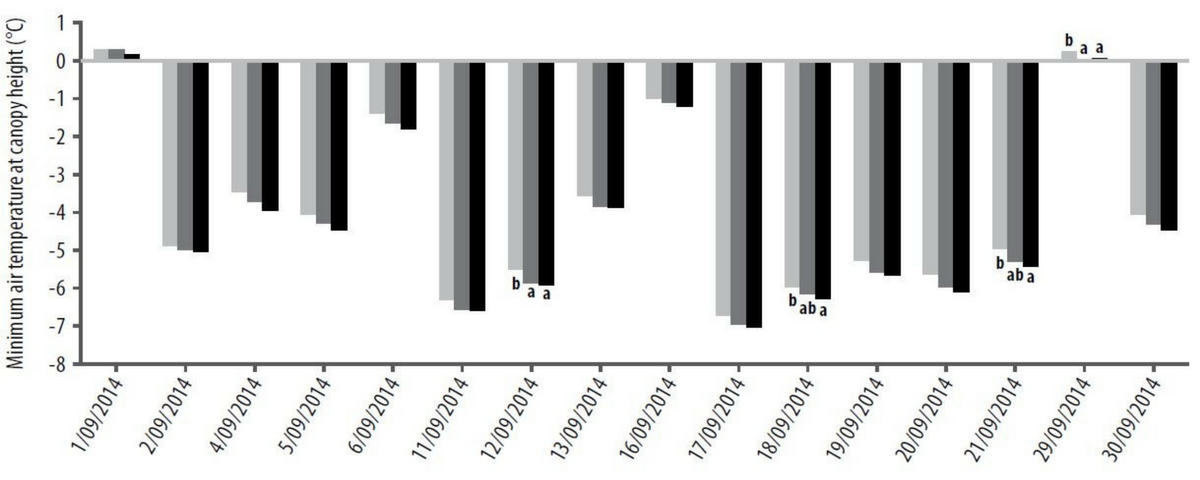
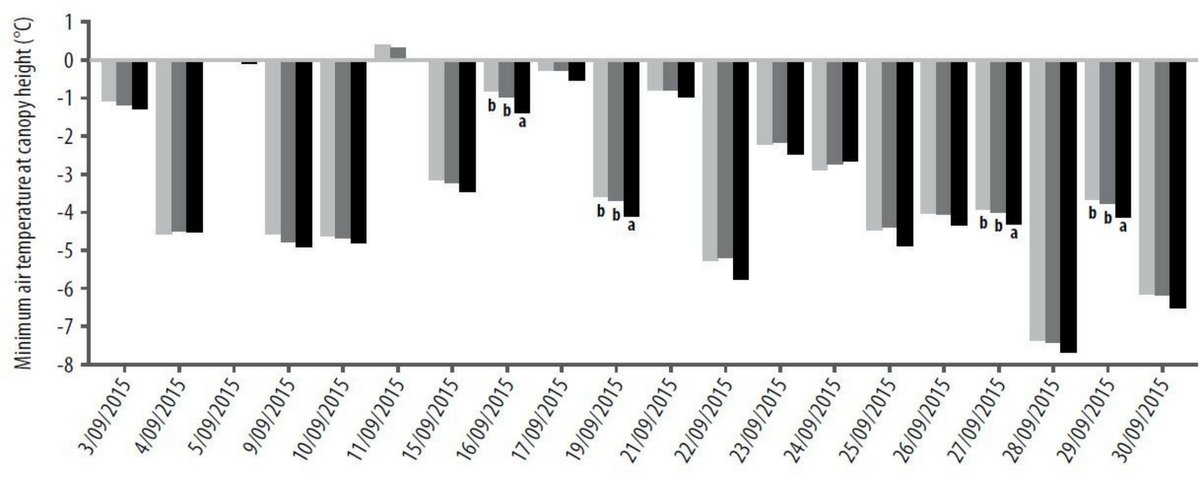
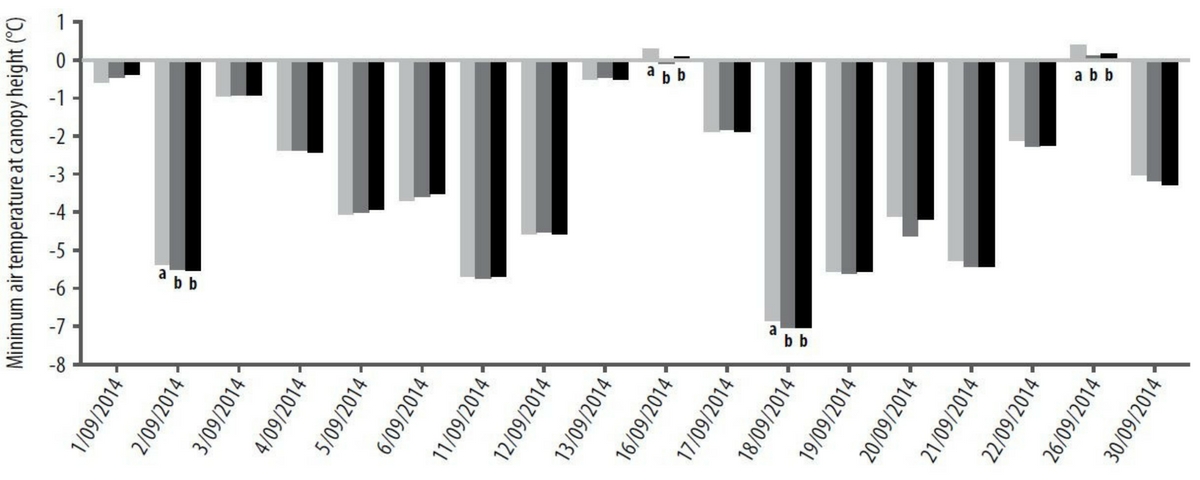

Frost duration was compared between treatments as the total cumulative time below successive temperature thresholds of 0, -1, -2,…-7°C for the time the temperature loggers were installed.
In the Mallee at Hopetoun in 2014 and 2015, retaining stubble increased the duration of the frost. The time spent below many of the temperature thresholds with retained stubble treatments was significantly colder and accumulating 10–15 more hours below 0, -1 and -2°C, than where stubble was removed. This impact was also apparent at lower temperatures as well (Figures 5 and 6).
In contrast in the Wimmera at both Lubeck in 2014 and Rupanyup in 2015 (Figures 7 and 8), retaining stubble did not increase the duration of the frost. At Lubeck in 2014 the crop grew vigorously and achieved complete canopy closure prior to heading. It is possible that the impact of stubble on the frost severity at canopy height was not observed due to the complete canopy closure in all treatments. Rupanyup in 2015 had a relatively low stubble load at seeding (~2.5t/ha) and this broke down rapidly to <1t/ha at anthesis, so in effect there was no difference in stubble load by the critical spring window.
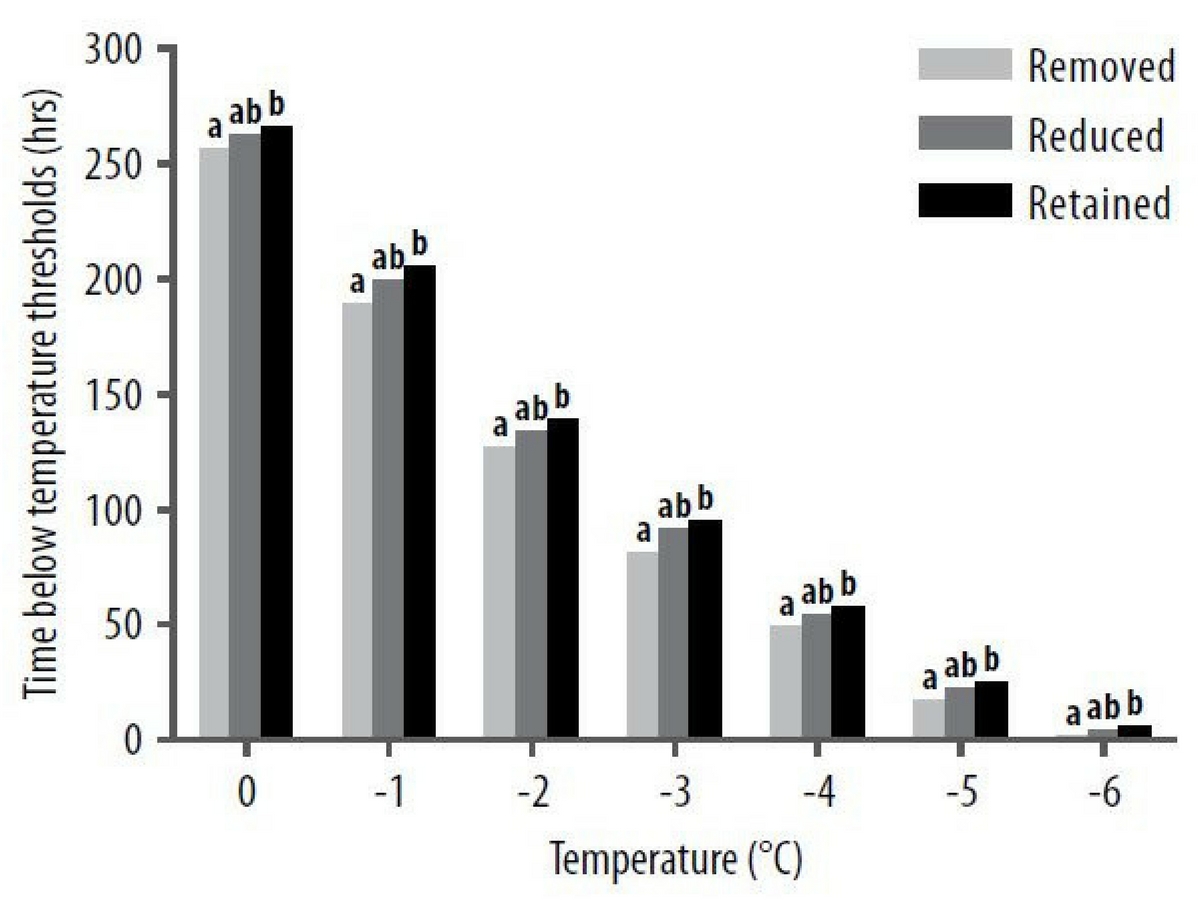

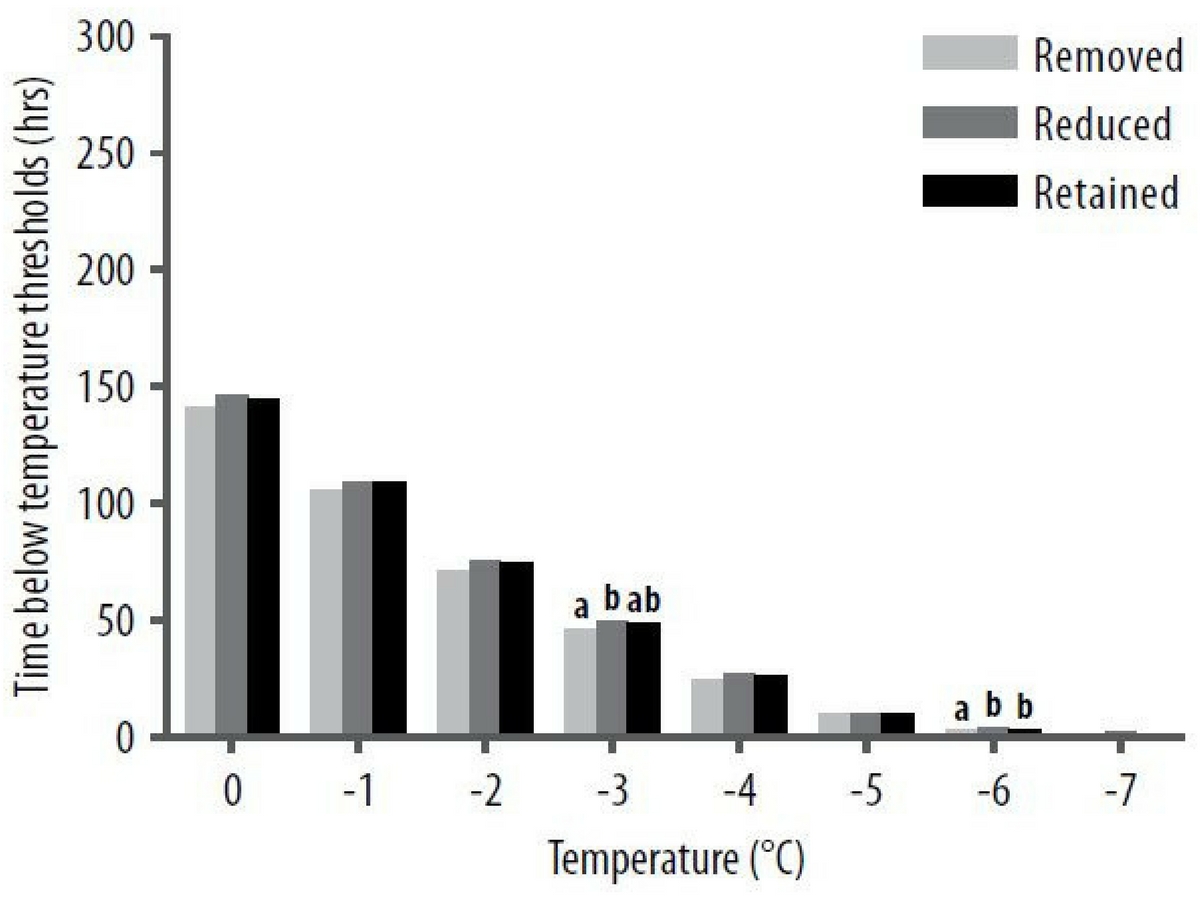
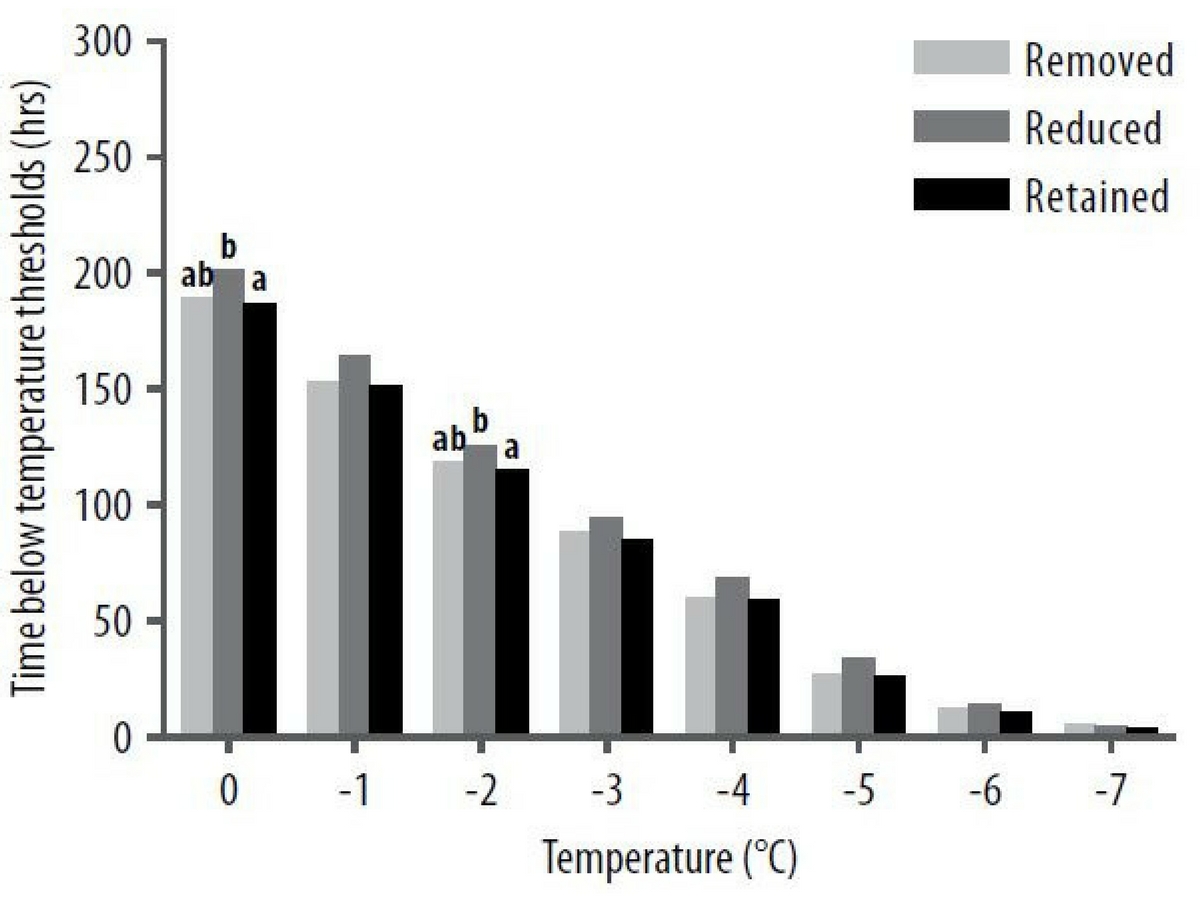
Temperature – effect of stubble load
The trial at Hopetoun in 2016 looked at the effect of a dose response of stubble rates (0, 1, 2 and 4t/ha) on the severity and duration of frost events. Increasing the stubble load increased the severity of the frost events in late August to early September with seven of the 12 frost events 4t/ha of stubble load having lower minimum temperatures (Figure 9). Increasing stubble loads also increased the duration of frost with the 4t/ha spending ~10-15 more hours below 0, -1 and -2 during August and September (Figure 10). 1t/ha and 2t/ha were often not significantly different from the 0t/ha treatment in terms of frost severity or duration.
From an agronomic point of view this means that managing stubble loads to <2t/ha at seeding at Hopetoun in 2016 reduced the frost risk comparable to complete stubble removal. This means complete stubble removal is not necessary or warranted to make best practice of stubble reduction to reduce frost risk, and that it is about getting it to a level that minimises (but not necessarily eliminates) the risk.
The impact of these treatments on floret sterility and yield were not assessed as the trial was
terminated in September due to weeds.
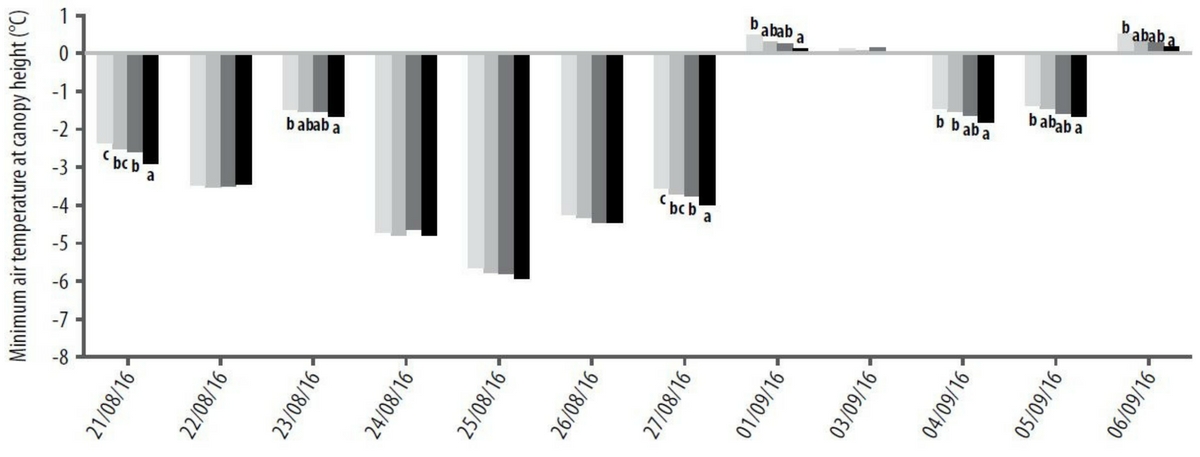
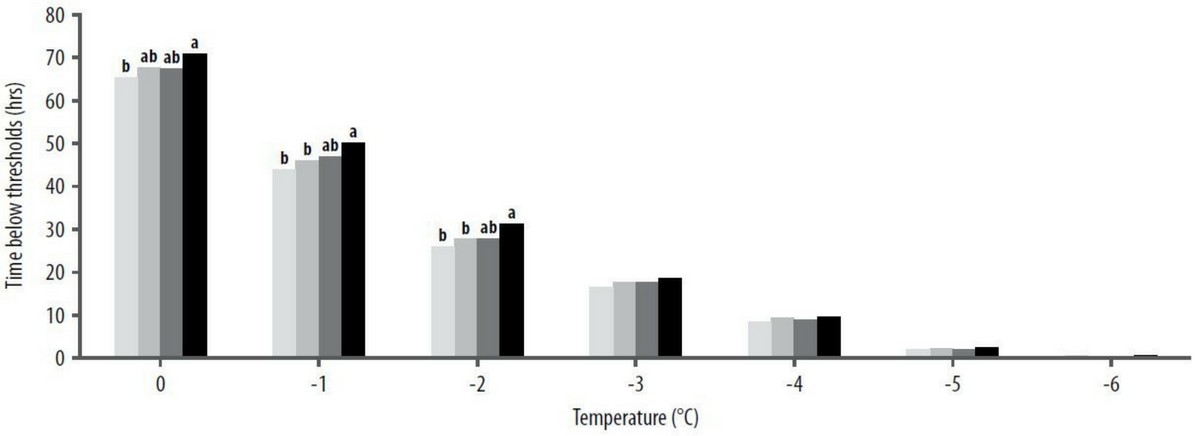
Grain yield, quality and sterility – stubble management effects
The change in frost severity and duration did not come through to changes in grain yield at these trials in either the Mallee or Wimmera. This is possibly due to the seasonal conditions that were presented with confounding large impacts of early stem elongation frost damage, as well as a dry spring in 2014 and terminal drought in 2015.
At Hopetoun in 2014 the barley crop achieved a maturity biomass of 4.7t/ha but only a grain yield of 1.0t/ha (Table 2). Across treatments there was an average harvest index of 0.22 and 50-60% floret sterility. A small difference in floret sterility was noted with retained stubble having 4% greater sterility (Table 2). There were significantly more non-viable heads in the stubble reduced and retained treatments, which was predominately made up of stems frosted at stem elongation (GS31-33), pers. observation.
Viable heads between treatments at maturity, and resultantly yield was the same across treatments. Given difference in tiller mortality it is hard to know if this was due to more tillers initially set in the reduced and retained treatments compared to removed, or whether it was due to greater retillering from frost damage as this was not assessed. Adding to this, rainfall from August-October onwards was only 23mm, meaning the impact of different stubble management practices on reducing frost damage at stem elongation may not have been transferred through to grain yield due to the poor finish to the season.
At Hopetoun in 2015, the trial had a maturity biomass of 5.6t/ha, harvest index of 0.40 and the stubble removed yielded 2.41t/ha, around 250kg more than stubble retained (Table 2). Despite the trial receiving several frosts during the flowering window, the level of frost damage was very low (FS<6%) and there was no stem elongation frost damage observed. The greater yield with stubble removal is not due to reduced frost damage (as it was so low at <6% FS) and may be due to nitrogen tie up with the stubble retention. This was supported by in-field observations of greater leaf area and early biomass production in the stubble removed treatments, early in-crop development (data not measured). The trial did have high screening and low retention due to terminal water stress again with a limited growing season rainfall (GSR) of 122mm. Terminal water stress was a major limiting factor in both the 2014 and 2015 trials at Hopetoun, and despite significant frost damage in 2014, it was the main reason for low yields and associated high screenings and small grain size.
Table 2. Grain yield, quality and assessment data from the Mallee: Hopetoun 2014 and 2015. Significance indicated by different letters (P<0.05).
At Lubeck in 2014, despite 40% frost damage, there was no difference between treatments for most yield and grain quality components measured. In 2014 the barley crop achieved a maturity biomass of 6.7t/ha but only a grain yield of 1.5t/ha (Table 3). Across treatments there was an average harvest index of 0.30. Despite large differences in stubble load at seeding (0t/ha vs 4.5t/ha), viable heads between treatments at maturity, and resultantly yield was the same across treatments. Good growing conditions early and narrow row spacing (9 inch) allowed the crop to achieve complete canopy closure by the time flowering occurred, and is thought to have negated the effect of the large differences in stubble load on canopy temperature.
In 2015 at Rupanyup, the trial had a maturity biomass of 5.1t/ha, harvest index of 0.40 and grain yield of 1.9t/ha. (Table 3). Despite the trial receiving several frosts during the flowering window the level of frost damage was very low (FS<5%) and there was no stem elongation frost damage observed. The trial had high screenings and low retention due to terminal water stress again with limited GSR of 160mm. No differences between treatments were noted and thought to be a result of quite low starting stubble biomass for the yield potential in this environment, as well as the possibility of high levels of mineralisation/breakdown in-season, or burial at sowing (not measured, based on photo references).
Terminal water stress was a major limiting factor in both the 2014 and 2015 trials at Lubeck and Rupanyup where yields were significantly below long-term averages and, despite significant frost damage in 2014, was the main reason for low yields and associated high screenings and small grain size.
Table 3. Grain yield, quality and assessment data from the Wimmera; Lubeck 2014 and
Rupanyup 2015. Significance is indicated by different letters (P<0.05).
Commercial practice
Frost is a real and present threat in Mallee and Wimmera production systems and over the past decade it appears the impact of frost is becoming more common, and more severe (Crimp et al. 2016). Stubble management is one potential tool growers can use to help manage frost risk as part of a comprehensive frost management plan (GRDC, Frost Management Tips and Tactics).
From three years of research in the Victorian Mallee and Wimmera, in conjunction with a multitude of research in other states, key learnings have been associated with frost damage and stubble management; the effect of stubble management with and without frost, and the effect of stubble load and effects under severe frosts.
In the Mallee at moderate yield potential (<2.5t/ha), reducing stubble loads at seeding under moderate frost events, to a level roughly equivalent to your grain yield potential is a good rule of thumb to reduce frost risk. For example, if yield is 2t/ha, stubble load is generally 4t/ha (harvest index of 0.5), so you need to reduce this back to 2t/ha prior to seeding to minimise risk.
This was supported by data at Rupanyup in 2015 where the relatively low stubble load of 2.5t/ha, was broken down below critical levels by spring and did not contribute to increased frost severity, duration or damage. However, under severe frost events, or at high yield potential seen in the Wimmera (>4t/ha) stubble management is likely to have minimal impact of frost severity or duration, and may not reduce it enough to have an impact on grain yield. Conversely, in the absence of frost, stubble removal from burning did not reduce grain yield but gave a small positive response (Hopetoun in 2015).
Unfortunately, the nature of frost can mean that measured differences in temperature in terms of duration and severity, do not always come through in differences in yields. For BCG research, this is largely thought to be a response to the seasonal conditions that were present in the years studied with 2014 and 2015 being exceptionally dry.
Research from Western Australia (Smith et al. 2017) has shown that in some trials the relationship between temperature and damage is well correlated and gives some confidence that stubble management may be warranted in frost prone landscapes.
Reference
Acknowledgements
This research was funded by the GRDC as part of the ‘Farming systems to manage frost’ project (DAW00241) and ‘Advancing profitable farming systems – frost risk management’ project (DAW00260) as part of the five year GRDC National Frost Initiative.
